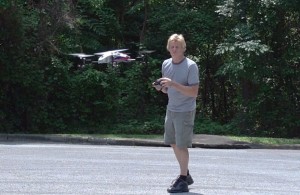One of the pleasures of the whole Solar Odyssey experience was my exposure to Hoverfly, who had signed on as a sponsor for Solar Odyssey (although it never actually happened).
I spend some time learning to fly with a base level model (no longer on their website) augmented with a lot more flying time with a Blade MQX quadcopter. The Blade MQX, although only a toy really, and able only to fly the weight of itself and its batteries, flies and responds like the Hoverfly Tech quadcopters. (They make six and eight rotor quadcopters for flying heavier cameras.)
The Hoverfly technology is amazing, which it needs to be because these quadcopters are a combination of hardware and very sophisticated software. Hoverfly’s platforms are GPS aware (including automatic return to base if it gets too far away), can be told to hover in place, automatically, and incorporates a very sophisticated camera gimble to keep the camera stable, no matter what the quadcopter is doing.
These are very sophisticated computers, designed for flying a quadcopter, and they are only going to get more sophisticated over time. While visiting their offices, I saw the future development path for Hoverfly’s technology, and it was largely about making them easier to fly and more automatic.
Right now, it takes a significant investment in practice time to become proficient with one of these quadcopters. I spend an average of 45 minutes a day (the flying time of my three batteries combined) with the Blade MQX over five weeks, and think I got about 85% of the way to “proficient enough”. What I realized though, is that the technology is going to make that skill base much less relevant, far faster than I anticipated.

All data points push towards a flying camera platform – more akin to a three-dimensional motion controlled camera than today’s remote control quadcopters – is inevitable. I’m aware of the issues on Studio films, where I suspect the push back is largely from the cadre of crane operators who don’t want to be displaced. So it will take time to get penetration there, but outside that, in the world of independent production, I can see a great future for these platforms.
I expect we’ll be able to automatically take off and land, but more importantly, be able to fly a pre-programmed path, hitting the appropriate way points and camera focus. It’d probably be possible to simply walk (on the ground) the path you want the camera to take, set and altitude and timing, and leave the rest to the camera/quadcopter to deal with.
The advantage is that these can add an enormous amount of production value: otherwise impossible (or simply impossibly expensive) motion controlled camera, or crane, shots become relatively easy.
To see where we’re going, instead of the $10K plus for a Hoverfly Venu or better, this Parrot® AR.Drone® 2.0 App-Controlled Quadricopter from Bookstone is just $300 and includes a 720P camera on board, the video electronics for remote viewing (see what the pilot sees) and an iPad/iPhone controller that simplifies the controls by tilting and positioning the iPad instead of standard controls. For the sake of research I’m forced to investigate this one just so I can report back on it.
As my friend Dan Spiess pointed out: for shooting over water perhaps having a $400 camera/quadcopter combo makes more sense than a $10,0000 + camera combo, given that both would be dead if they landed in salt water. Of course, the built-in 720P camera in the Parrot AR Drone isn’t going to displace the image quality from an NEX7, which is what I was hoping to fly.
If you do have the quadcopter skills and an available machine, you can make a whole bunch of money flying it for productions (away from the Studios), but be aware that I think it’s a short window before the software develops enough to take over.
[Update] Just to show how mainstream this has become, take a look at this Flashmob video. High production values: two cranes and at least half a dozen ground level cameras. But also note the shots at approximately 1’27, 2’01, 2’40, 3’51 and 4’25. I figure there are two remote controlled helicopter based cameras although possibly only one. Â You can see them in the background around 2’22, 4’53 and 5’20. They don’t appear to be quadcopters but I don’t have the magic CSI “zoom in and get great close ups” technology handy! Also see the use of an iPad as video recorder around 3’24!
Another video shows some amazingly simple (but otherwise difficult) shots at or near ground level, not even traditional remote control territory. Once this is affordable, it will become ubiquitous and we’ll have a whole new level of shakey-cam to entertain us. And then it will settle down to being a useful everyday production tool.
4 replies on “Small production footprint: flying cameras [Updated]”
I’m really interested in this topic. What venues outside of commercial production would you recommend to look into for someone in a non-major market?
Real estate fly overs are very popular particularly for high value properties. But when the price and ease of use comes down, they’re just another camera angle choice, but often camera angles that would not be available otherwise. Check out the demo reels on Hoverfly’s showcase http://www.hoverflytech.com/Shot_on_Hoverfly.html
Would be nice to see a few footage that you have shot with that, Philip.
The Blade MQX can carry its battery – nothing more. I never flew a helicopter with a camera. 🙁 I’m thinking of changing that with the Parrot AR Drone.